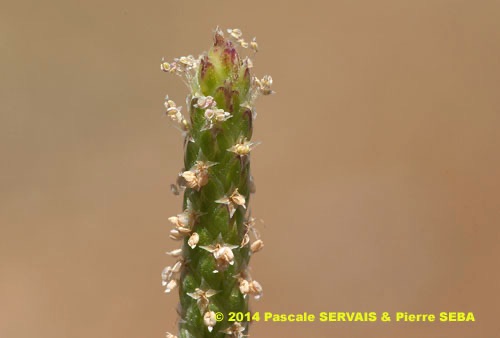
Plantago coronopus L.
Fam. : Plantaginaceae
© Pascale SERVAIS & Pierre SEBA, 2018. Tilo Botanica: Flore de Tilos et du Dodécanèse / Flora of Tilos and of the Dodecanese
English translation by Brenda Bradbury, Howard Bradbury and Stéphane Léonard
Plante herbacée, hermaphrodite, aplatie sur le sol et supportant bien le piétinement, à souche ligneuse.
Feuilles à la base, divisées pennatiséquées, vert pâle, de 10 à 20 cm de long, étroites, parfois poilues, souvent ciliées, à lobes linéaires et pointus. Bractées de la base des fleurs élargies à leur base, membraneuses sur les bords, ovales, pointues au sommet, égalant le calice ou plus longues.
Fleurs à symétrie radiaire, brun jaunâtre, de 2,5 à 5 mm de diamètre, réunies en épis cylindriques ou ovales-allongés de 5 à 12 cm de long, dépassant les feuilles et rayonnant à partir d’un point central. Hampes florales sans feuilles et à poils appliqués. Corolle à 4 pétales soudés en tube membraneux discret. Calice à 4 sépales soudés à la base, dont 2 à carène formant une aile membraneuse et ciliée sur le dos. 4 étamines égales entre elles, saillantes, à anthère jaune pâle. 1 style dépassant la corolle et terminé par 1 stigmate. Ovaire supère.
Fruits, capsules à 3 à 6 graines.
___________________________
Plant herbaceous, hermaphrodite, flattened on the ground and very resistant to trampling, with a woody stock.
Leaves at the base, dissected pinnatisect, pale green, from 10 to 20 cm long, narrow, sometimes hairy, often ciliate, with linear and pointed lobes. Bracts of the base of the flowers extended at their base, membranous on the edges, ovate, pointed at the top, equalizing the calyx or longer.
Flowers radially symmetrical, yellowish brown, from 2.5 to 5 mm in diameter, joined together in cylindrical or ovate-lengthened spikes from 5 to 12 cm long, exceeding the leaves and spreading from a central point. Floral poles without leaves and with appressed hairs. Corolla with 4 petals fused in a membranous, inconspicuous tube. Calyx with 4 partly fused sepals, including 2 keel-shaped forming a wing membranous and ciliate on the back. 4 stamens equal to each other, protruding, with a pale yellow anther. 1 style exceeding the corolla and finished by 1 stigma. Ovary superior.
Fruits, capsules with 3 to 6 seeds.
Descripteurs / Identifying features
1
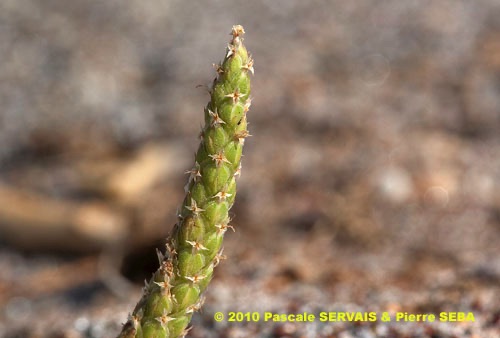
2
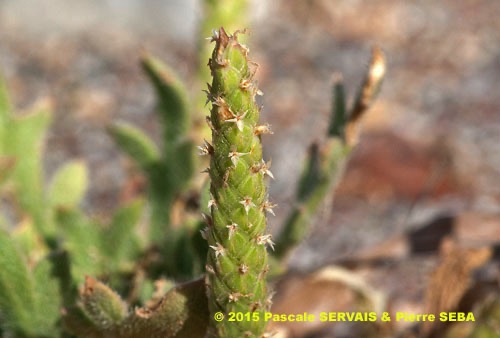
3
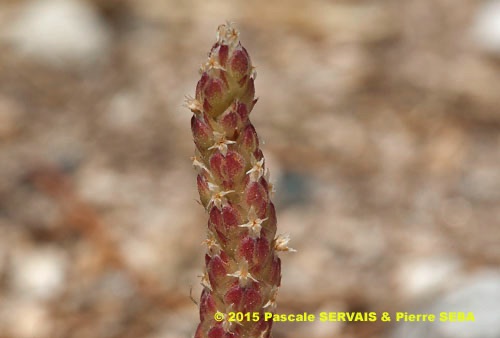
4
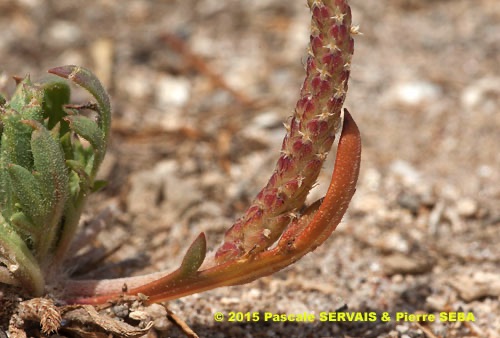
5
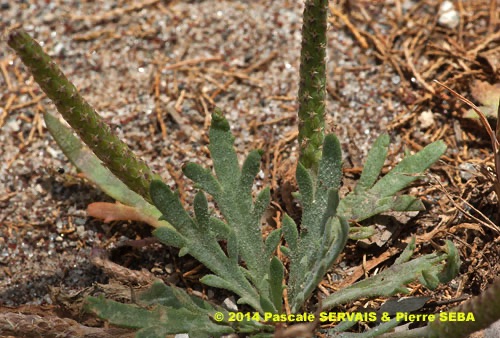
6
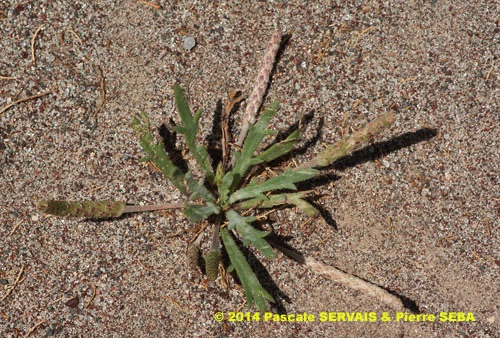
7
Étymologie / Etymology :
Plantago : emprunt du latin plantago, -inis (nom) [ < planta, -ae (nom)
= la plante + ago, -is, -ere (verbe) = faire, agir ] = le plantain, nom
donné à la plante par Pline, naturaliste latin mort en 79 apr. J.-C.,
en référence à ses nombreuses propriétés médicinales.
Coronopus : emprunt du latin coronopus, -odis (nom) = le plantain corne
de cerf, nom donné à la plante par Pline, naturaliste latin mort en
79 apr. J.-C., forme latinisée du grec ancien κορωνόπους, -ποδος
(nom) [ < κορώνη, -ης (nom) = la corneille + πούς, ποδός (nom)
= le pied ] = le pied de corneille, nom donné à la plante par
Théophraste, philosophe péripatéticien, disciple d’Aristote, botaniste et
naturaliste, mort vers 288 av. J.-C., en référence aux feuilles
découpées ressemblant à l’empreinte d’un pied d’oiseau.
Plantago : borrowed from Latin plantago, -inis (noun)
[ < planta, -ae (noun) = plant + ago, -is, -ere (verb) = to do, to act ]
= plantain, name given to the plant by Plinius, Latin naturalist died
in 79 AD, referring to its medicinal properties.
Coronopus : borrowed from Latin coronopus, -odis (noun) = buck’s-horn
plantain, name given to the plant by Plinius, Latin naturalist died in
79 AD, Latinized form of the Classical Greek κορωνόπους, -ποδος
(noun) [ < κορώνη, -ης (noun) = crow + πούς, ποδός (noun) = foot ]
= crow's foot, name given to the plant by Theophrastus, peripatetic
philosopher, disciple of Aristotle, botanist and naturalist, died towards
288 BC, referring to the cleft leaves resembling a footprint of a
bird's foot.
Synonyme / Synonym :
—
Noms vernaculaires / Common names :
Noms français / French names :
Pied-de-corneille — Plantain corne-de-cerf.
Noms grecs / Greek names :
Κατουρόχορτο — Κοκοράκι — Κορακοπόδι — Κυπαρισσόχορτο —
Πεντάνευρο — Περδικοπάτημα — Πετεινόχορτο — Πυκνόχορτο —
Τσαλαπετεινός — Χηνοπόδι — Ψαλιδόχορτο.
Noms anglais / English names :
Buck’s-horn plantain — Welden’s plantain.
Noms allemands / German names :
Dickblättriger Wegerich — Krähenfuß-Wegerich —
Krähenfußblättrige Wegerich — Schlitzblättriger Wegerich —
Weldens Wegerich — Wolliges Gliedkraut.
Nom espagnol / Spanish name :
Estrellamar.
Nom italien / Italian name :
Piantaggine barbatella.
Habitat :
Prairies - Lieux pierreux - Lieux incultes - Sols sableux - Chemins.
Meadows - Stony places - Waste ground - Sandy soils - Waysides.
Île / Island :
Tilos.
Hauteur / Height range :
De 10 cm à 30 cm.
From 10 cm to 30 cm.
Floraison / Flowering time :
De février à septembre.
From February to September.
Groupe / Classification :
Dicotylédones.
Dicotyledons.
Pérennité / Lifespan :
Annuelle, bisannuelle ou vivace.
Annual, biennial or perennial.
Description :
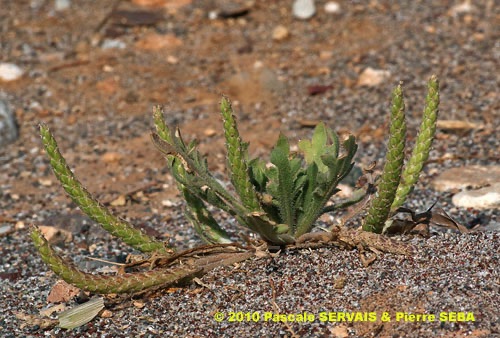
8
Clés dichotomiques et descripteurs distinctifs des 7 espèces / Dichotomous keys and distinctive identifying features of the 7 species
Photo 1 :
Localisation / Location : Tilos, Megalochorio, Erystos
Date : 20/05/2014
GPS : Lat. 36,43324° N / Long. 27,34999° E / Alt. 3 m
Type : Photographie numérique / Digital Photograph (10 mégapixels)
Photo 2 :
Localisation / Location : Tilos, Megalochorio, Erystos
Date : 12/05/2010
GPS : Lat. 36,43300° N / Long. 27,35102° E / Alt. 2 m
Type : Photographie numérique / Digital Photograph (10 mégapixels)
Photo 3 :
Localisation / Location : Tilos, Megalochorio, Erystos
Date : 12/05/2010
GPS : Lat. 36,43300° N / Long. 27,35102° E / Alt. 2 m
Type : Photographie numérique / Digital Photograph (10 mégapixels)
Photo 4 :
Localisation / Location : Tilos, Megalochorio, Erystos
Date : 26/05/2015
GPS : Lat. 36,43324° N / Long. 27,34999° E / Alt. 3 m
Type : Photographie numérique / Digital Photograph (10 mégapixels)
Photo 5 :
Localisation / Location : Tilos, Megalochorio, Erystos
Date : 26/05/2015
GPS : Lat. 36,43324° N / Long. 27,34999° E / Alt. 3 m
Type : Photographie numérique / Digital Photograph (10 mégapixels)
Photo 6 :
Localisation / Location : Tilos, Megalochorio, Erystos
Date : 20/05/2014
GPS : Lat. 36,43324° N / Long. 27,34999° E / Alt. 3 m
Type : Photographie numérique / Digital Photograph (10 mégapixels)
Photo 7 :
Localisation / Location : Tilos, Megalochorio, Erystos
Date : 20/05/2014
GPS : Lat. 36,43324° N / Long. 27,34999° E / Alt. 3 m
Type : Photographie numérique / Digital Photograph (10 mégapixels)
Photo 8 :
Localisation / Location : Tilos, Megalochorio, Erystos
Date : 12/05/2010
GPS : Lat. 36,43300° N / Long. 27,35102° E / Alt. 2 m
Type : Photographie numérique / Digital Photograph (10 mégapixels)

Google Maps
Google Maps
Google Maps
Google Maps
Google Maps
Google Maps
Google Maps
Google Maps